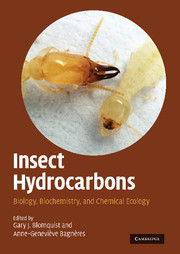Book contents
- Frontmatter
- Contents
- List of contributors
- Foreword
- Acknowledgments
- Part I Chemistry, Biochemistry, and Physiology
- 1 Introduction: history and overview of insect hydrocarbons
- 2 Structure and analysis of insect hydrocarbons
- 3 Biosynthesis of cuticular hydrocarbons
- 4 Molecular biology and genetics of hydrocarbon production
- 5 Site of synthesis, mechanism of transport and selective deposition of hydrocarbons
- 6 Cuticular lipids and water balance
- 7 Chemical taxonomy with hydrocarbons
- 8 Chemical synthesis of insect cuticular hydrocarbons
- 9 Oxygenated derivatives of hydrocarbons
- Part II Chemical Communication
- Index
5 - Site of synthesis, mechanism of transport and selective deposition of hydrocarbons
from Part I - Chemistry, Biochemistry, and Physiology
Published online by Cambridge University Press: 18 May 2010
- Frontmatter
- Contents
- List of contributors
- Foreword
- Acknowledgments
- Part I Chemistry, Biochemistry, and Physiology
- 1 Introduction: history and overview of insect hydrocarbons
- 2 Structure and analysis of insect hydrocarbons
- 3 Biosynthesis of cuticular hydrocarbons
- 4 Molecular biology and genetics of hydrocarbon production
- 5 Site of synthesis, mechanism of transport and selective deposition of hydrocarbons
- 6 Cuticular lipids and water balance
- 7 Chemical taxonomy with hydrocarbons
- 8 Chemical synthesis of insect cuticular hydrocarbons
- 9 Oxygenated derivatives of hydrocarbons
- Part II Chemical Communication
- Index
Summary
Our understanding of the site of synthesis, transport and deposition of insect cuticular hydrocarbons has undergone a paradigm shift in the last few decades. In the model that prevailed until the early 1980s, newly synthesized hydrocarbons exited the epidermal cells where they were synthesized, were transported through pore canals and then formed an outer layer on the cuticle (Locke, 1965; Hadley, 1981). The picture presented polar head groups of fatty acids interacting with the cuticle, with the hydrocarbons layered on top of the acyl chains of fatty acids. This served as an excellent model in which to test a number of hypotheses, many of which are still unanswered. However, it is now clear that cuticular hydrocarbons are synthesized by oenocytes, either associated with epidermal cells or within the peripheral fat body, and that the newly synthesized hydrocarbons are taken up by lipophorin and transported via the hemolymph. The mechanism of how they get transferred from lipophorin to epidermal cells, cross the epidermal cells and then to the surface of the insect and to specific glands is unknown. There is great selectivity in the process, as a number of lepidopterans are able to selectively transport shorter-chain hydrocarbon pheromones and pheromone precursors to the pheromone gland on the abdomen, whereas longer-chain cuticular hydrocarbons are transported to cover the entire cuticle (Schal et al., 1998a; Jurenka et al., 2003).
- Type
- Chapter
- Information
- Insect HydrocarbonsBiology, Biochemistry, and Chemical Ecology, pp. 75 - 99Publisher: Cambridge University PressPrint publication year: 2010
- 26
- Cited by



